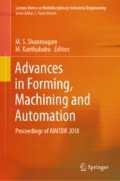Abstract
Hard turning has found to be a viable method for machining hard parts like cemented tungsten carbides. This method is effective and efficient with polycrystalline diamond (PCD)—a superhard cutting tool with a longer tool life. The objective of this paper is to optimize the cutting parameters for multimodal grade of PCD. Round full face PCD insert with hardness of greater than 9000 HV is used for turning WC–Co–Ni–Cr (15% Binder) mill rolls on CNC lathe. The responses like taper, cycle time, flank wear, and maximum spindle load are recorded. Optimal cutting parameters have been obtained from consideration of different responses. Abrasion on the flank is found to be the major wear mechanism.
Access this chapter
Tax calculation will be finalised at checkout
Purchases are for personal use only
References
Koepfer, C.: Hard turning as an alternative to grinding, production machining. Gardner Business Media (2010)
Frayman, L.I.: Cemented carbide material for hot rolling application. General Carbide Corporation, Greensburg, PA 15601, USA (1) (2010)
Innovations Master catalogue @2012 by Kennametal Inc., Latrobe, PA 15650 USA, pp. B140
Coppini, N.L., Diniz, A.E., Bonandi, M., De Souza, E.M., Baptista, E.A.: Hard turning of sintered cemented carbide parts: a shop floor experience. 4th CIRP Conference on Modeling of Machining Operations (CIRP CMMO). Procedia CIRP 8, 368–373 (2013)
Heo, S.J.: Environmentally conscious hard turning of cemented carbide materials on the basis of micro-cutting in SEM: stressing four kinds of cemented carbides with PCD tools. J. Mech. Sci. Technol. 22, 1383–1390 (2008)
Zębala, W., Kowalczyk, R., Matras, A.: Analysis and optimization of sintered carbides turning with PCD tools. Procedia Eng. 100, 283–290 (2015)
Nath, C., Rahman, M., Neo, K.S.: Machinability study of tungsten carbide using PCD tools under ultrasonic elliptical vibration cutting. Int. J. Mach. Tools Manuf. 49, 1089–1095 (2009)
Miyamoto, T., Fujiwara, J., Wakao, K.: Influence of WC and Co in cutting cemented carbides with PCD and CBN tools. Key Eng. Mater. 407–408, 428–431. Online: 2009-02-20. ISSN: 1662-9795
Author information
Authors and Affiliations
Corresponding author
Editor information
Editors and Affiliations
Essential Questions
Essential Questions
-
1.
What is your main contribution to the field?
Once the objective of the project was set, I started doing literature survey on machinability of tungsten carbide in turning and arrived at a conclusion that I had to use a PCD tool which is efficient and cost-effective. Hence, we fixed the PCD tool based on its mechanical properties and its usage capability. I had to do preliminary experiments to understand the cutting action of selected tool. Based on the experiments, I was able to decide the parts per edge and wear mechanisms. The next phase was again with a motto of conducting experiments in order to understand the cutting action. After this, I was able to conclude on fixing the cutting parameters. Gathered the information in order to find cost per component and tried my best to suggest an optimized parameter for the hard outer diameter turning of cemented tungsten carbide rolls.
-
2.
What is novel? In theory, in experimental techniques, or a combination of both?
We used full face PCD tool than normal tipped PCD tools. The tool used is a different grade of PCD than optimal recommendation from diamond tool manufacturers for turning cemented tungsten carbides. In experimental technique, we used a different tool geometry for outer diameter turning which is usually used for profile turning operation. We were able to effectively use the cutting edges to reduce the CPC.
-
3.
Does your paper have industrial applications? If yes, who are the likely user?
Yes it has a wide usage in hard turning of cemented tungsten carbide rolls or any other component made of hardmetals. Hardmetal manufacturers are the likely users.
-
4.
How this work is different from past research work (yours and others)?* (please include this statement in the paper).
Our work stands apart from others in selecting a different grade of PCD and utilization of the PCD tool effectively to reduce the CPC. Past research works focused mainly on using tipped PCD tools and surface finish and flank wear were the major responses. We focused on industrial requirements and considered few other responses.
Rights and permissions
Copyright information
© 2019 Springer Nature Singapore Pte Ltd.
About this paper
Cite this paper
Hunakunti, M.J., Jagannath, V., Rao, R.S., Srinivas, S., Shyamsundar, S., Ashokkumar, D. (2019). Optimization of Cutting Parameters for Hard Turning of WC–Co–Ni–Cr (15% Binder) Mill Rolls on CNC Lathe with Polycrystalline Diamond. In: Shunmugam, M.S., Kanthababu, M. (eds) Advances in Forming, Machining and Automation. AIMTDR 2018. Lecture Notes on Multidisciplinary Industrial Engineering. Springer, Singapore. https://doi.org/10.1007/978-981-32-9417-2_36
Download citation
DOI: https://doi.org/10.1007/978-981-32-9417-2_36
Published:
Publisher Name: Springer, Singapore
Print ISBN: 978-981-32-9416-5
Online ISBN: 978-981-32-9417-2
eBook Packages: Chemistry and Materials ScienceChemistry and Material Science (R0)

